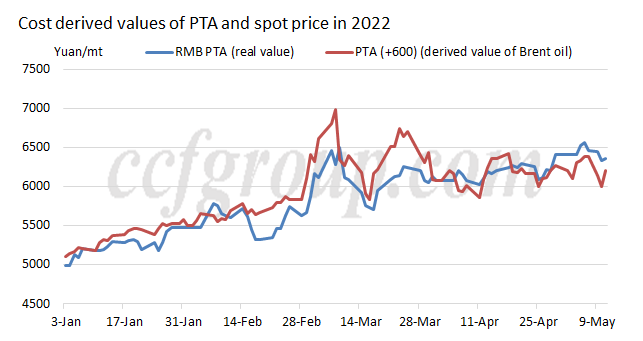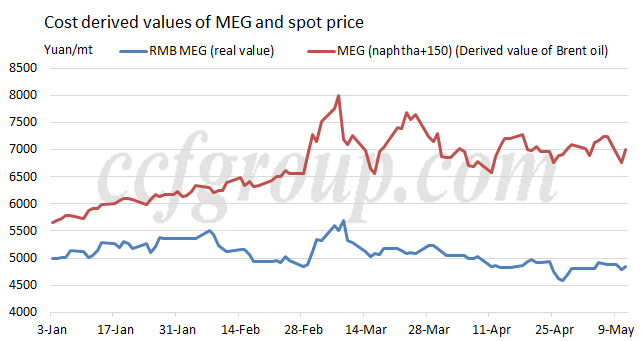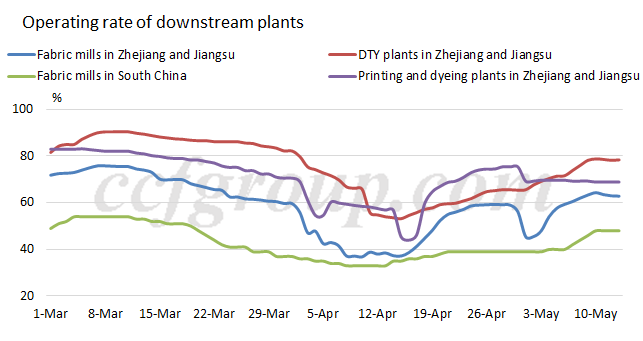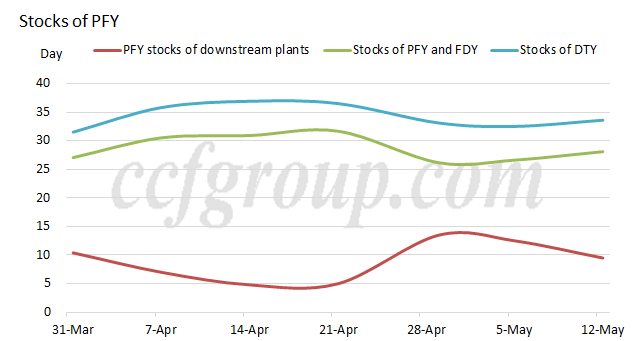By mid-May, the logistics in Zhejiang, Jiangsu, Fujian and Guangdong has been basically recovered to the level in late-Mar. Among production bases of PFY and downstream products, only factories in Jiangyin, Jiangsu was under strict regulation amid the pandemic.
Transportation has improved while PFY market was pressed by upstream and downstream market.
The comprehensive polymer raw material cost ascended with consolidating oil price, firmly upward naphtha-PX-PTA chain and rising MEG price due to restoring fundamentals. The root was global energy supply issue resulted from the Russia-Ukraine conflict. Therefore, the support from cost side was obvious.


Prices of PFY sped up to rise in May stimulated by increasing raw material market and to reduce losses. Taking conventional flat POY150/288 as an example, discounted price was at 7,500yuan/mt in end-Apr and it moved up to 8,600yuan/mt by May 16, with increment at 1,100yuan/mt. Prices of other POY also increased by around 1,000yuan/mt, while those of FDY was less at 500-600yuan/mt and those of DTY were the lowest as it was more close to the terminal market. Price of conventional grey fabrics was hard to climb up and some plants even cut price for promotion.
With quickly rallying price, the profit of PFY apparently improved. As a result, the stocks obviously appreciated and the cash flow losses dropped. The losses of conventional POY narrowed to current 300yuan/mt from 700yuan/mt in end-Apr and those of FDY reduced to 500yuan/mt from 700yuan/mt in end-Apr.
| Cash flow of PFY in 2022 (Unit: yuan/mt) | ||||||
| Period | POY | FDY | ||||
| Melting cost based on spot raw material prices | Melting cost based on 10-workday average of raw material prices | Melting cost based on 20-workday average of raw material prices | Melting cost based on spot raw material prices | Melting cost based on 10-workday average of raw material prices | Melting cost based on 20-workday average of raw material prices | |
| Q1 | 53 | 145 | 250 | -121 | -30 | 75 |
| Jan | 103 | 234 | 391 | -125 | 6 | 163 |
| Feb | 252 | 254 | 315 | 39 | 41 | 102 |
| Mar | -124 | -10 | 83 | -223 | -109 | -16 |
| Apr | -413 | -424 | -412 | -340 | -352 | -340 |
| May* | -278 | -126 | -83 | -234 | -81 | -39 |
The operating rate of downstream fabric mills was recovering since mid-Apr. In May, downstream plants witnessed limitedly increasing orders due to rising cost. Stocks of fabrics were still mainly above one month, higher above 2 months, which occupied much working capital. However, price of fabrics was hard to move up and the cash flow was during negative territory.

Therefore, downstream plants were resistant to highly-priced feedstock and cautious in restocking. The PFY stocks of downstream plants decreased in May, while PFY companies saw mounting inventory again, but stocks of PFY rose slower than early-Apr under low operating rate.

Demand has improved weakly, while players still lack confidence when stocks of grey fabrics are high, price is hard to rise and orders sustain limited. Operating rate of fabric mills and DTY plants started falling last week, mainly circular knitting plants in Xiaoshan and Shaoxing and warp knitting mills in Haining among fabric mills and DTY plants in Cixi, Xiaoshan and Shaoxing.
Price uplift will be helpful for the recovery of market confidence while too rapid increase will do more harm than good. Under such circumstance, downstream players will see bigger losses based on spot raw material prices and show lower activity in production. Downstream buyers may be forced to restock to cover the pressing demand in short run, while if it sustains long, downstream DTY plants and fabric mills are likely to be compelled to scale down output again, especially in end-May/early-Jun with the coming of Dragon Boat Festival (Jun 3-5). PFY producers are expected to see high stocks, weak demand and firm cost in the second half of May. They may choose to cut run rate and slash price by that time.